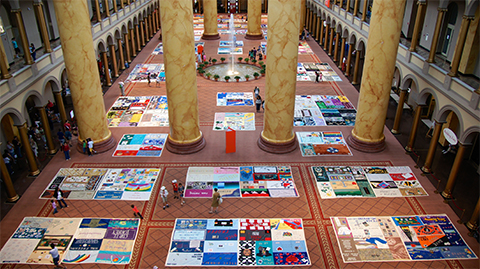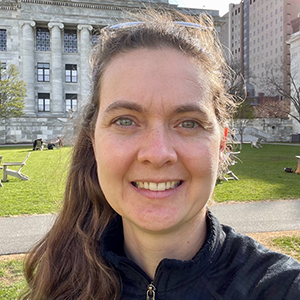
My queerness helped me see myself as a scientist again
When my ninth year of graduate school begins, I feel like a failure. Everyone else in my cohort has graduated, I have no first-author publications, and the project I’ve been working on for the past four years has been overhauled due to a lack of results. I don’t know how to integrate this experience with my previous run of academic successes. Sometimes I can’t fall asleep because I’m sobbing so hard.
I am also struggling to identify a post-Ph.D. career for myself, and I meet with a career services adviser. She asks me to reflect on what I enjoy, my interests and my values.

For the past six months, I’ve spent all day, six days a week, writing scripts to visualize and explore a proteomics data set. The data set itself is a consolation prize — I’m working with it as a result of the research project overhaul. But I enjoy the analysis. So, I tell her that. I also say that my interests are books and queer culture.
The adviser doesn’t comment on my interests, but she does tell me I should be a data scientist. I understand why, but it’s not the answer I’m looking for. I’m hoping for an out from my identity crisis. If my future career has nothing to do with science, then there’s an easy explanation for the failure I’ve experienced: I’m just not a scientist.
I find comfort in my queerness. Queer book club is my favorite Zoom activity, I listen to episodes of a podcast that recaps the TV show “The L Word” to relax and I heal my adolescent didn’t-realize-she-was-gay self by reading queer young adult books.
When I was an undergrad, discovering that I enjoyed research and felt at home in a lab, I also came out as gay, lesbian, queer. It made my life make sense. During graduate school, identifying as a scientist and a Ph.D. student felt more important.
Now, looking at my bookshelf, I think harder about my interest in queer culture. I am particularly interested in the queer history of the HIV/AIDS pandemic in the U.S.
In my sophomore year, my biochemistry professor presented a slide of yearly deaths in the U.S. due to various causes that highlighted the dramatic rise and decline of those attributed to HIV/AIDS. He then introduced us to triple combination anti-retroviral therapy. It left a lasting impression on me.
I listened to a similar lecture on the science of HIV in graduate school as part of the course for which I was a teaching assistant. I discussed the lecture with a friend, and she bought me a copy of Randy Shilts’ book about the AIDS crisis, “And The Band Played On.” I read more; the history is so much more complex than the scientific successes that the courses celebrated.
Learning about the HIV/AIDS pandemic expands my understanding of being queer. My queerness is more than whom I date; it’s also about being part of a community with a long history of fighting against the status quo and caring for each other.
Previously, when I thought about science in my future, I envisioned leaving the basic science of my Ph.D. research and doing something that could explicitly impact communities I care about. My exploration focused on reproductive health. But now, after reflecting on my interest in queer culture, I realize that, of course, the HIV pandemic continues.
In the U.S., HIV disproportionately impacts Black men who have sex with men and trans women, the Centers for Disease Control and Prevention reports. Globally, cis women make up close to 50% of new cases, according to the Joint United Nations Programme on HIV/AIDS.
I reach out to a colleague who worked on HIV immunology for his Ph.D. I start identifying drug companies that work in HIV prevention and treatment, and I start an online course titled “AIDS: Fear and Hope.”
Eighteen months after the career services meeting, with my Ph.D. thesis successfully defended and my “mini-postdoc” finishing my papers coming to a close, I see a posting for a bioinformatics job working on HIV vaccine development. It’s at an academic institute in the city where I’m planning to move. I apply. I still haven’t escaped my science identity crisis, and I constantly dream of leaving science altogether. But I decide that I can’t walk away just yet; I need to give it one more try.
The day I move into my new apartment, I get an email about an interview for the job. When the interviewer asks why I applied, I say that learning about the HIV/AIDS pandemic has been an important part of connecting with my queer identity. At the end of the afternoon, I am walked to the director’s office. On the atrium wall, I see a quilt — each section oriented around a name. I immediately know what it is: a panel of the AIDS Memorial Quilt. In 1987, almost 2,000 panels, handcrafted by friends and families of the deceased as a physical testament of loss and love, were displayed at the National Mall during the Second National March on Washington for Lesbian and Gay Rights.
A month later, I start the job. Of course, I love the scripting and analysis, but I’m surprised to realize that I’m excited about the data and the scientific approach too. Also, I am not terrible at it. It turns out I am a scientist, and I’m incredibly grateful to feel some confidence in that identity again.
I’m also grateful for my queerness. It’s an identity I don’t feel I need to earn, and leaning into it brought me to where I am now. Every day, as I take the path through the institute to and from my office so I can pass the quilt, I remember the weight of the HIV/AIDS pandemic past and present, and I feel the connection between my queer self and my scientist self.
Enjoy reading ASBMB Today?
Become a member to receive the print edition four times a year and the digital edition monthly.
Learn moreFeatured jobs
from the ASBMB career center
Get the latest from ASBMB Today
Enter your email address, and we’ll send you a weekly email with recent articles, interviews and more.
Latest in Opinions
Opinions highlights or most popular articles

The tortoise wins: How slowing down saved my Ph.D.
Graduate student Amy Bounds reflects on how slowing down in the lab not only improved her relationship with work but also made her a more productive scientist.

How pediatric cataracts shaped my scientific journey
Undergraduate student Grace Jones shares how she transformed her childhood cataract diagnosis into a scientific purpose. She explores how biochemistry can bring a clearer vision to others, and how personal history can shape discovery.

Debugging my code and teaching with ChatGPT
AI tools like ChatGPT have changed the way an assistant professor teaches and does research. But, he asserts that real growth still comes from struggle, and educators must help students use AI wisely — as scaffolds, not shortcuts.

AI in the lab: The power of smarter questions
An assistant professor discusses AI's evolution from a buzzword to a trusted research partner. It helps streamline reviews, troubleshoot code, save time and spark ideas, but its success relies on combining AI with expertise and critical thinking.

How AlphaFold transformed my classroom into a research lab
A high school science teacher reflects on how AI-integrated technologies help her students ponder realistic research questions with hands-on learning.

Writing with AI turns chaos into clarity
Associate professor shares how generative AI, used as a creative whiteboard, helps scientists refine ideas, structure complexity and sharpen clarity — transforming the messy process of discovery into compelling science writing.

